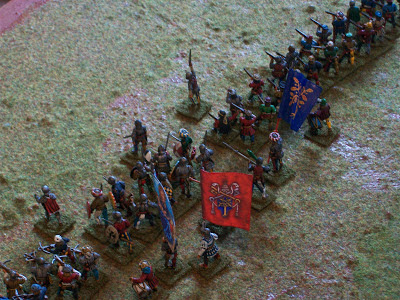 |
| Mounted Crossbowmen |
Todays post if of the lastest troops I have been working on, Mounted Crossbowmen from the beginning of the Sixteenth Century. They are all Perry Miniatures and a third have had head swaps as I wanted to bring them a little more in the 1500s with the Tudor caps and didn't want lots of the figures to be the same. I am really pleased with how they have turned out and I think they will fit in well with the collection so far. Its a shame the plastic horses they come on are way bigger than the Foundry, TAG and Eureka horses so they cannot be easliy mixed in, but on the other hand they are much cheaper because of it! I also like the fact that none of them are firing from horseback as I am not convinced this is how these troops were deployed. I have always imagined them acting like later dragoons and dismounting to engage and then mounting and riding off if they need to. That's not to say they may have fired when mounted when occasion demanded though.
I have shown the head swaps I did below, as well as a picture from above to show some of the changes to the horses harness (is this the correct word?). I have already painted 12 of these plastic horses for my light cavalry and didn't want to paint another 12 just as they were so made some changes to a few of them with green stuff. I still have a long way to go with the green stuff but it is all good practice!
 |
| Mounted Crossbowmen |
 |
| Head swap with a plastic perry head |
 |
| Head swap with a plastic perry head |
 |
| Head swap with a metal Tudor head |
 |
| Head Swap with a metal Tudor head |
 |
| Shot from above to show a few changes to the horses |
At the weekend I was lucky enough to travel to Vienna. I was extremely keen to go and see this :
http://www.albertina.at/jart/prj3/albertina/main.jart?rel=en&reserve-mode=active&content-id=1202307119317&ausstellungen_id=1215680392292 and it was well worth it. I tried to get a few photos but they were terrible as its pretty dark and busy in the exhibition. The Triumph of Maximilian is simply spectacular and the wealth of other sculptures, woodcuts, paintings, objects and armour they have is fantastic. Its not that large, being in four smallish rooms, but is well worth it if you are into this period, especially the northern style of art. I have never seen so many pictures of Landsknechts, Gendarmes and artillery! I also picked up the accompanying book:
http://www.amazon.co.uk/Emperor-Maximilian-I-Age-Durer/dp/3791351729/ref=sr_1_1?ie=UTF8&qid=1352195912&sr=8-1 . This looks fantastic having essays on Maximilian I and detailed desciptions, and great photos, of most of the stuff in the exhibition. I look forward to slowly making my way through it, its an enormous tome!
I also saw the Armour Collection at the Hofburg which was again quite overwhelming, they have so many harnesses from the 15-16th century. I have shown a couple of things below. The Army Museum in the Arsenal focused more fo the 17th Century onwards but I found it interesting. One surprise find was while in the Art History Museum, which has some great Durer and Breughel paintings, I stumbled upon the entire set of Tapestries depiciting Charles Vs conquest of Tunis in 1535. There was no labelling on them at all so I am unsure of when they were made or how contemporary they are to the campaign but the detail on them is fantastic. They are in these enormous glass cases which made photographing them a nigthmare.
For this era Vienna has an enormous amount to see and I would highly recommend the Maximilian and Durer exhibition.
 |
| Out of focus of a section of the Triumph of Maximilian |
 |
| One of Maximilians suits of Armour c.1485 and part of the Triumph of Maximilian behind |
 |
| Harness from the 1520s in the Hofburg, Vienna |
 |
| Pieces fof Tournament Armour designed to "explode" from the Hofburg, Vienna |






































































